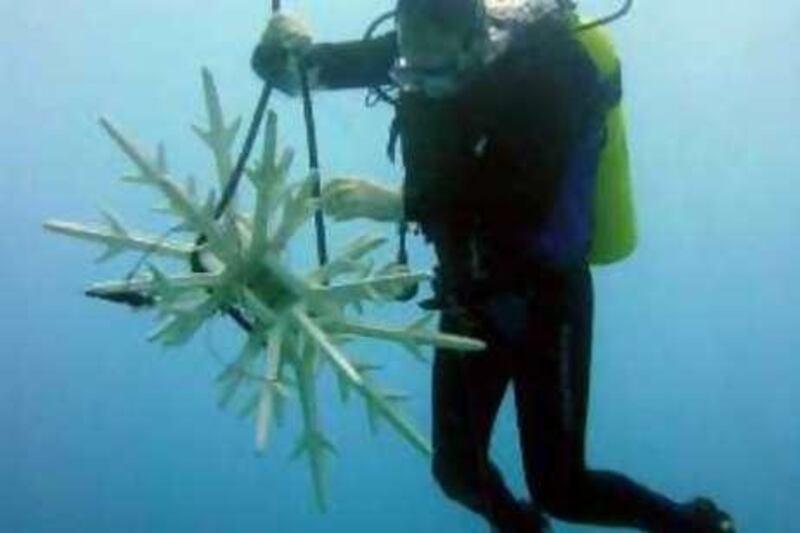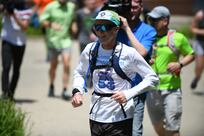ABU DHABI // Scientists are considering the use of artificial reefs to restore coral communities damaged by development. Although the deployment of artificial structures to support reef growth is now allowed only for scientific research, the Environment Agency - Abu Dhabi (EAD) is looking to use them after studies showed the effectiveness of certain structures. A complete list of guidelines is incomplete, however, because some of the experiments are not finished.
Because of the high salinity and water temperatures in the Gulf, corals are already living on the edge. In recent years, oil pollution, unmanaged coastal development and unregulated commercial and recreational fishing have added to the pressures on the delicate marine animals. A document - the result of a three-year collaboration that included the Emirates Wildlife Society, World Wide Fund for Nature and the EAD - said coral-reef coverage off the coast of Abu Dhabi is at a record low.
Sixty five per cent of Abu Dhabi's coral is already lost. However, there are signs of resilience, and if the right protection and mitigation measures are put in place, a full recovery could follow, the document says. Although artificial reefs are illegal, the law is flouted, said Ashraf al Cibahy, head of the EAD's marine protected areas section. "In all emirates, fishermen apply artificial reefs in certain areas of the sea to collect fish. They are convinced from their experience that any three-dimensional structure will attract fish, either to hide in, to feed or as nursery grounds."
Three broad categories of materials could be used to create artificial reefs: discarded materials such as cars, boats, and construction waste; natural materials such as wood and rock; and concrete mixes, PVC and fibreglass. EAD decided to test the use of materials from concrete, reviewing products available from companies in Fujairah, Dubai and Abu Dhabi. The first type of structure to be tested, known as reef ball, was made by the National Cement Company in Dubai. The dome-shaped structures, a mixture of cement and gravel, are pH-neutral, so as not to change the chemical balance of the seawater. Achieving pH neutrality is difficult because cement is usually highly alkaline.
The scientists installed 50 units, each weighing 400kg, in an area in the Marawah Marine Biosphere Reserve west of Abu Dhabi island. The units were scattered in groups of various size over a hectare. The installation started in late 2006. "We chose a site that has a no-take zone," said Mr Cibahy said. "If you put the site in an area that is open to fishermen, the results of the study will not be accurate."
"The site had to be solid ground with middle-strength current and, most importantly, minimal life so we can compare the before and after." The scientists also installed a 25-square-metre monitoring station close to the experiment site so they could compare colonisation rates at the two locations. The experiment was to compare the two locations in terms of the frequency and abundance of species of fish, coral and other forms of marine life, the percentage coverage per square metre as well as the biomass content for different groups of important species.
Within six months, the two locations were showing some remarkable differences, said Mr Cibahy. While at the reference site, scientists located only six species of shells with a relatively small number of individuals, the experiment site was much richer in terms of the variety and total number of shell species. Shells had a coverage of 10 per cent per square kilometre - a high number. The above applied to other species of marine life - fish, coral, seagrass, algae, sea slugs and other forms of underwater life.
EAD is also testing two other structures. The Fish Haven Tower is a pyramid-like structure, weighing more than 600kg. Fifty units were installed in the reserve 18 months ago. In May, the scientists started a third experiment, with a structure known as EcoReefs. Made of unglazed ceramic, they resemble the branches of coral species such as Acropora, a common coral here. These structures, are much easier to install than the others, because they weigh only 40g. Deployment was finished in August and the first results are expected in March, Mr Cibahy said.
The scientists have already drawn some conclusions about the use of artificial reefs. "Concrete is a very durable and stable material that is also easily available," Mr Cibahy said. "It is flexible to cast and offers excellent surface for habitat settlement for encrusting organisms." The only drawback is that concrete structures "are heavy and require specialised equipment to handle them". The study has resulted in recommendations to issue a decree to govern permitting and monitoring of artificial reefs in Abu Dhabi, he said.
@Email:vtodorova@thenational.ae






